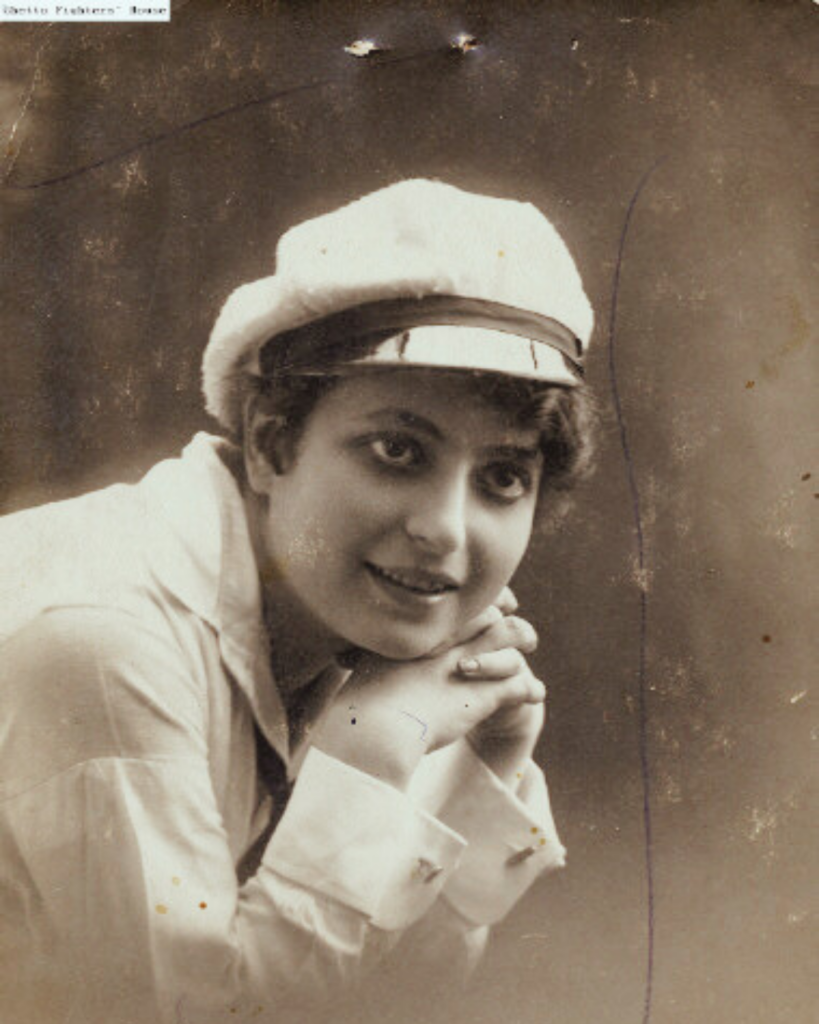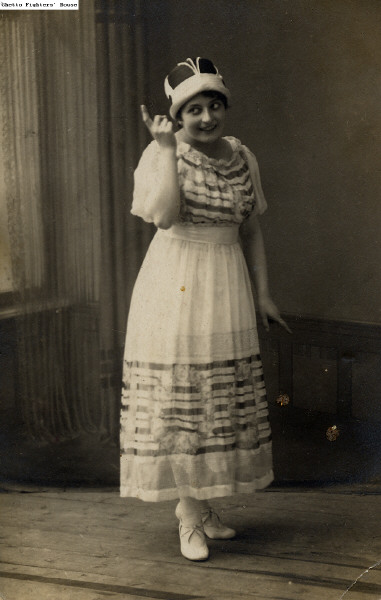Ida Erwest/Erwestówna (1895 – 1942)
Singer, comedy actress, composer, revue dancer.
She was born in 1895, probably in Warsaw, as Ida Ajerwajs. Some sources mention her birth year as 1905, but this seems incorrect, as she was already performing as an adult singer in 1917. She was married twice, and from her second marriage, she had a son.
Ida began her artistic career as a chorus girl and dancer in a Jewish theater. During World War I, she was noticed by Salomon Kustin, a popular actor who came from the USA and organized a Jewish cabaret in Poland. Kustin hired Erwest for his traveling cabaret theater. Their performances on a tour in areas occupied by the German-Austrian army were extremely popular.

Ghetto Fighters House | Jonas Turkow collection
Jonas Turkow, an actor and writer, recalls (in his book Farloshene Shtern) that in 1917, at the beginning of his career, he was part of Kustin’s troupe and performed alongside Erwest on stage. “I was then a witness to the indescribable success that Ida Erwest achieved. She was called ‘the queen of Jewish song.'”
The couplets sung by Ida were so popular, according to Turkow, that the audience coming to her performances knew them by heart and sang along with the artist. Most of the cabaret songs were written and composed by her. The popularity of these songs was evidenced by the fact that they were heard in many cafés and restaurants in various cities.
Turkow wrote: “She attracted attention not so much for her beautiful voice, her magnificent dancing, but for her appearance. […] She was as beautiful as an angel, with large, fiery eyes full of delicacy and affection. She sang with such grace, such heart and feeling, that she easily won people’s affection.”
During Kustin’s tour, the audience mainly consisted of Jews serving in the Austro-Hungarian army, who, after spending several years at the front, longed for art in their native language. Young Ida, singing in Yiddish and dancing on stage, won the admiration of the audience. Her admirers composed songs about her. One of them, set to music by a famous Austrian composer, became a well-known soldiers’ song, and it went:
“Ida Erwest, oh how beautiful you are. I don’t want to live without you. When you disappear, the sun goes out. Please, stay”.
Turkow further recalls: “When, after the performances, we went with Ida Erwest to a nightspot, upon our arrival, everyone stood up and sang the song ‘Ida Erwest, oh how beautiful you are…’ I’ve often witnessed scenes where tables and chairs flew in restaurants if any soldier dared to say something inappropriate about Ida.”

In the 1920s and 1930s, she mainly performed in revue and comedy theaters. From July 1, 1928, she was part of the ensemble of the “Qui pro Quo” theater — the most popular cabaret of the interwar period. She also performed abroad. In the Trubadur Warszawski weekly, on March 14, 1931, it was written: “Ida Erwest. A highly talented revue artist, after achieving success in Vienna, returned to the country with a hit repertoire, enjoying unprecedented popularity everywhere.”
By the late 1930s, her career had somewhat diminished, and she mainly performed in restaurants. In 1938, she was employed by Isaac Gertner to perform on the stage of his venue, “Bar Central,” at Leszno Street 2.
After the outbreak of the war, in the early months of the occupation, Erwest was one of the artists invited to perform at concerts organized by household committees, as well as at private homes and courtyards. In early 1940, when the Café Gertner on Tłomackie 13 received permission to organize artistic performances, it hired both Jewish and Polish artists. Ida Erwest was one of the first to be engaged. She performed there with her son, a talented violinist. Despite the fact that sometimes, during the performances, Germans would enter and take the gathered audience members to work or confiscate their money or valuables, as Jonas Turkow recalls, the success of these performances was enormous. People literally fought to get in.
After the closure of the Warsaw Ghetto’s borders, Ida and her son found themselves trapped there. She performed at the Melody Palace musical theater and other venues, where she sang “joyful songs of the old good times, which were warmly received by the ghetto residents, for who among them did not long for the past?” (Turkow).
According to his memories, Ida Erwest was also forced to perform in a German propaganda film made in the ghetto in the spring of 1942. She was murdered in the summer of 1942 during the great liquidation action of the ghetto.
Bibliography:
- Turkow. Jonas, „Farloszene sztern”, tom I, Buenos Ajres 1952
- Turkow Ionas, „C’était ainsi: 1939-1943, la vie dans le ghetto de Varsovie”, Paryż 1995
- „Echo Artystyczne. Organ Polskiego Związku Artystów Widowiskowych”, zeszyt 10, 1930
- Trochimczyk Maja (ed.), „A Romantic Century in Polish Music”, Los Angeles 2009
- Błaszczyk Leon Tadeusz, „Żydzi w kulturze muzycznej ziem polskich”, Warszawa 2014
- „Trubadur Warszawski”, nr 2, 1931
- „Trubadur Warszawy”, nr 13, 1933
- „Express Zagłębia”, r. 8, nr 257, 1933

